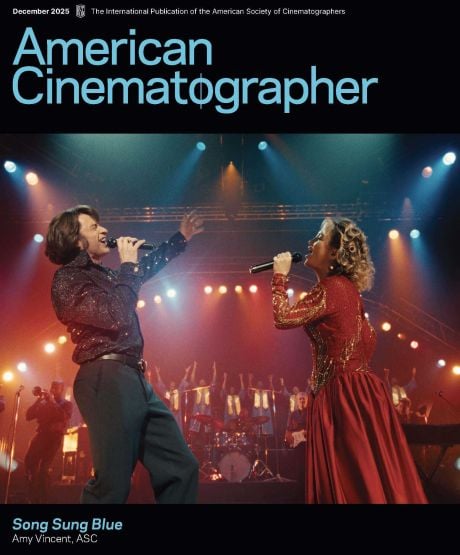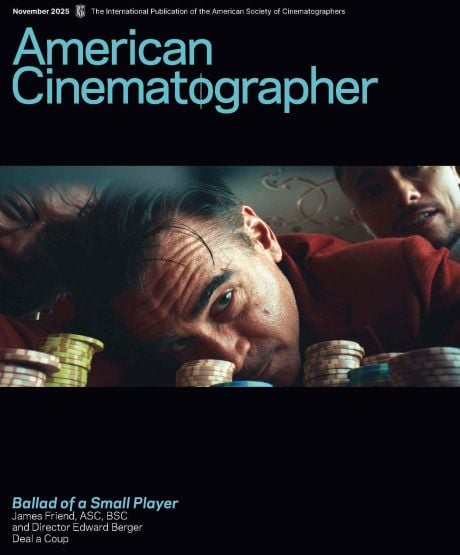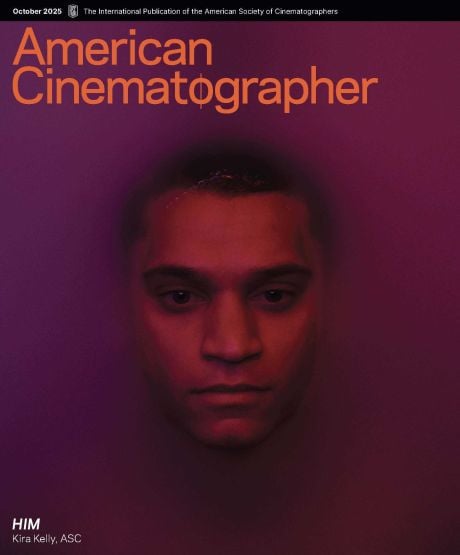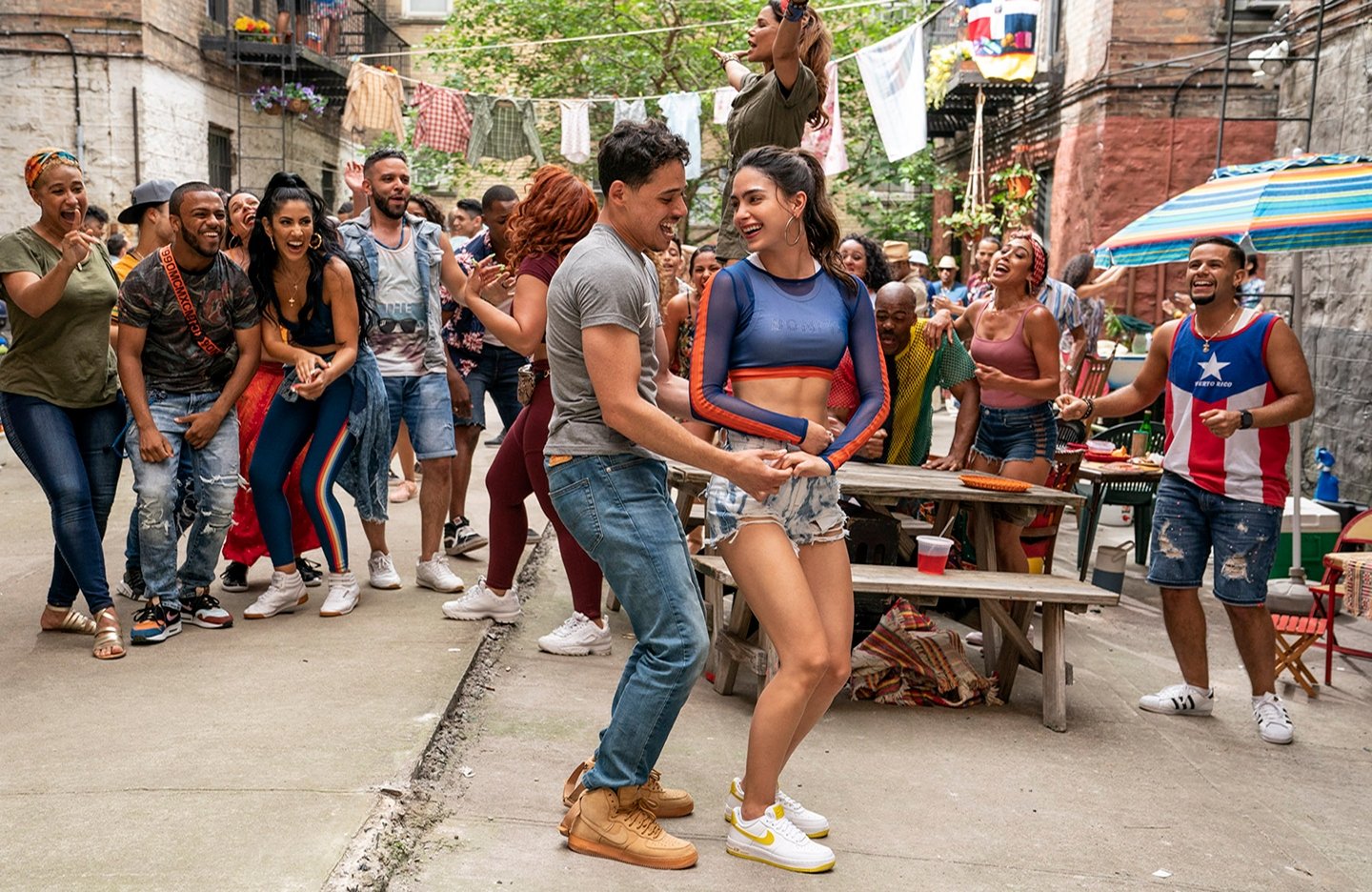
In The Heights: A Musical Block Party
Shot by Alice Brooks, this modern musical celebrates a New York neighborhood’s vibrant culture.
Photos by Macall Polay, courtesy Of Warner Bros. Pictures
Cinematographer Alice Brooks’ collaboration on In the Heights with director Jon M. Chu and choreographer Christopher Scott was a creative pinnacle the trio had unknowingly been climbing toward for their entire careers. The project itself, a feature adaptation of the Tony Award-winning stage musical by Lin-Manuel Miranda and Quiara Alegría Hudes, had also been two decades in the making; Miranda completed his first draft of the piece in 1999, while he was still a student at Wesleyan University.
The story’s plot centers on a part of New York City that is rarely explored or celebrated in the media: Washington Heights, a predominantly Dominican and Latinx neighborhood in the uppermost part of Manhattan. It’s a section of the city that’s “made of music,” according to the movie’s protagonist, Usnavi (Anthony Ramos), and Miranda himself, who explains to AC that the area has that reputation “because it’s loud! That’s literally the inspiration for the musical — my neighborhood has more music in it than everybody else’s.”
Chu was attached to the project in 2016, prior to the success of his feature Crazy Rich Asians, and he asked Brooks to join him on the feature while the two were working together shooting the pilot of the Apple TV Plus series Home Before Dark (AC July ’20). Brooks was the right cinematographer for the job, he says, because In the Heights was the culmination of two decades of “our friendship and our creative collaboration together.” They had previously worked together on the musical drama Jem and the Holograms (AC Nov. ’15), but had known each other since they were undergrads at the USC School of Cinematic Arts.
“Alice was like a legend at USC film school,” Chu says. While still a junior, Brooks had written a script for one of the four thesis films selected to be made, and also served as the project’s cinematographer. “Everyone was like, ‘Who is this person?’” Chu recalls. “I said to myself, ‘I need to work with her.’ But she was way cooler than me; I was the nerdy guy who liked musicals.” However, when Chu was a senior, his project — a musical — was selected, “and the only person I wanted [to shoot it for me] was Alice.”
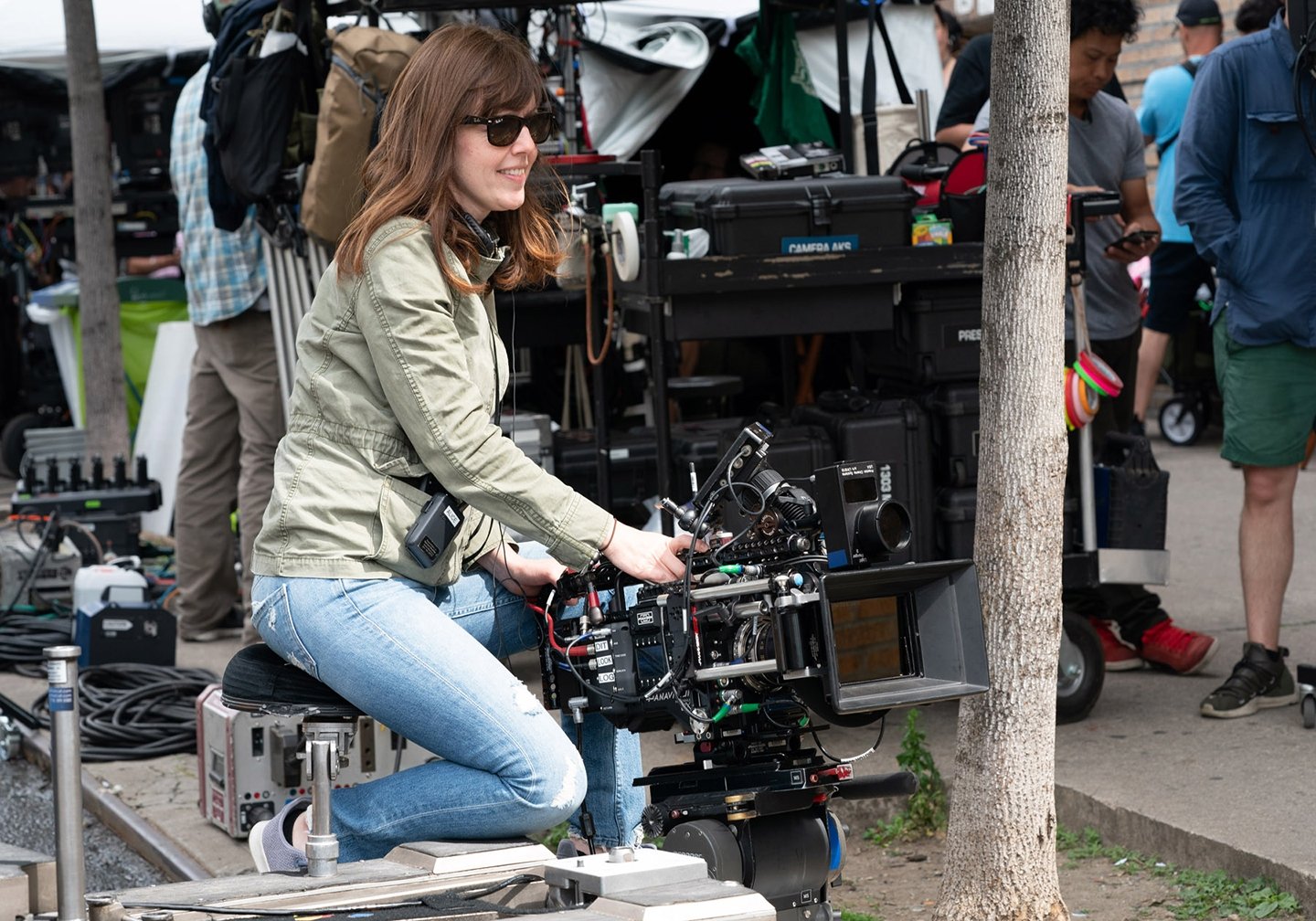
“In the Heights is the visual culmination of our 20 years working together.”
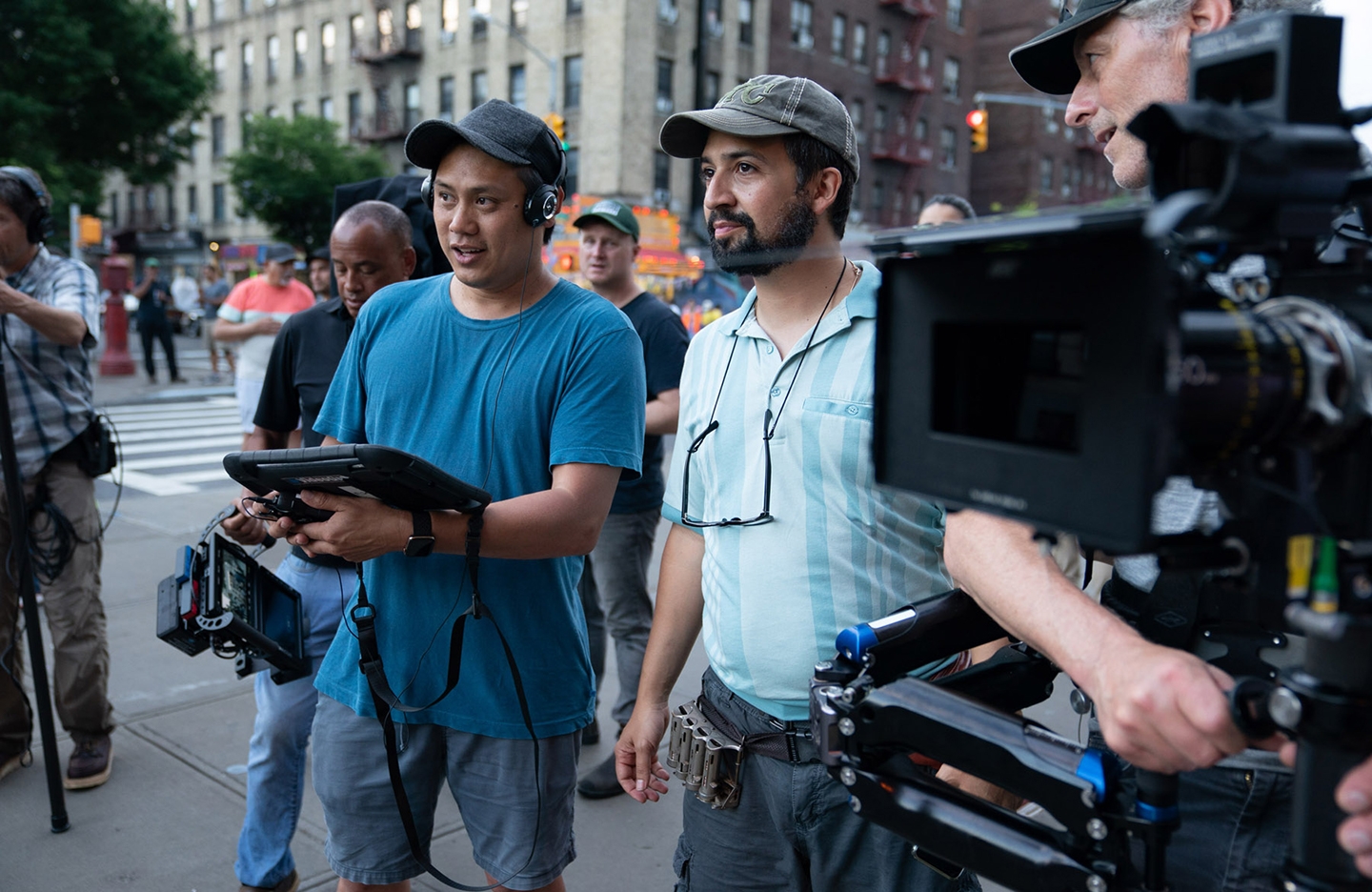
They met up at a Starbucks, and Chu was delighted to discover that Brooks was also an avid fan of musicals. “I love everything about them,” she says. “I grew up watching Fred Astaire and Ginger Rogers, and The Sound of Music and My Fair Lady.” Given their mutual appreciation for the genre, the duo decided to collaborate on Chu’s thesis, When the Kids Are Away. Says Chu, “We’d literally been training for In the Heights since that day at Starbucks when we talked about why we love musicals. When words weren’t enough, the camera and the shots could put you in a seat that only the cinema could take you to.” Adds Brooks, “If you watch that short, you can see how In the Heights is the visual culmination of our 20 years working together.”
They first teamed up with choreographer Scott while collaborating on three seasons of the web series The Legion of Extraordinary Dancers (aka The LXD — see AC Oct. ’10). “We did experiments on those episodes, [which] spanned all genres — from film noir to Westerns to horror, all of which were 90-percent dance,” Chu says. “We made a lot of mistakes, but we also found things that we couldn’t have found [otherwise]. It was a laboratory for us.”
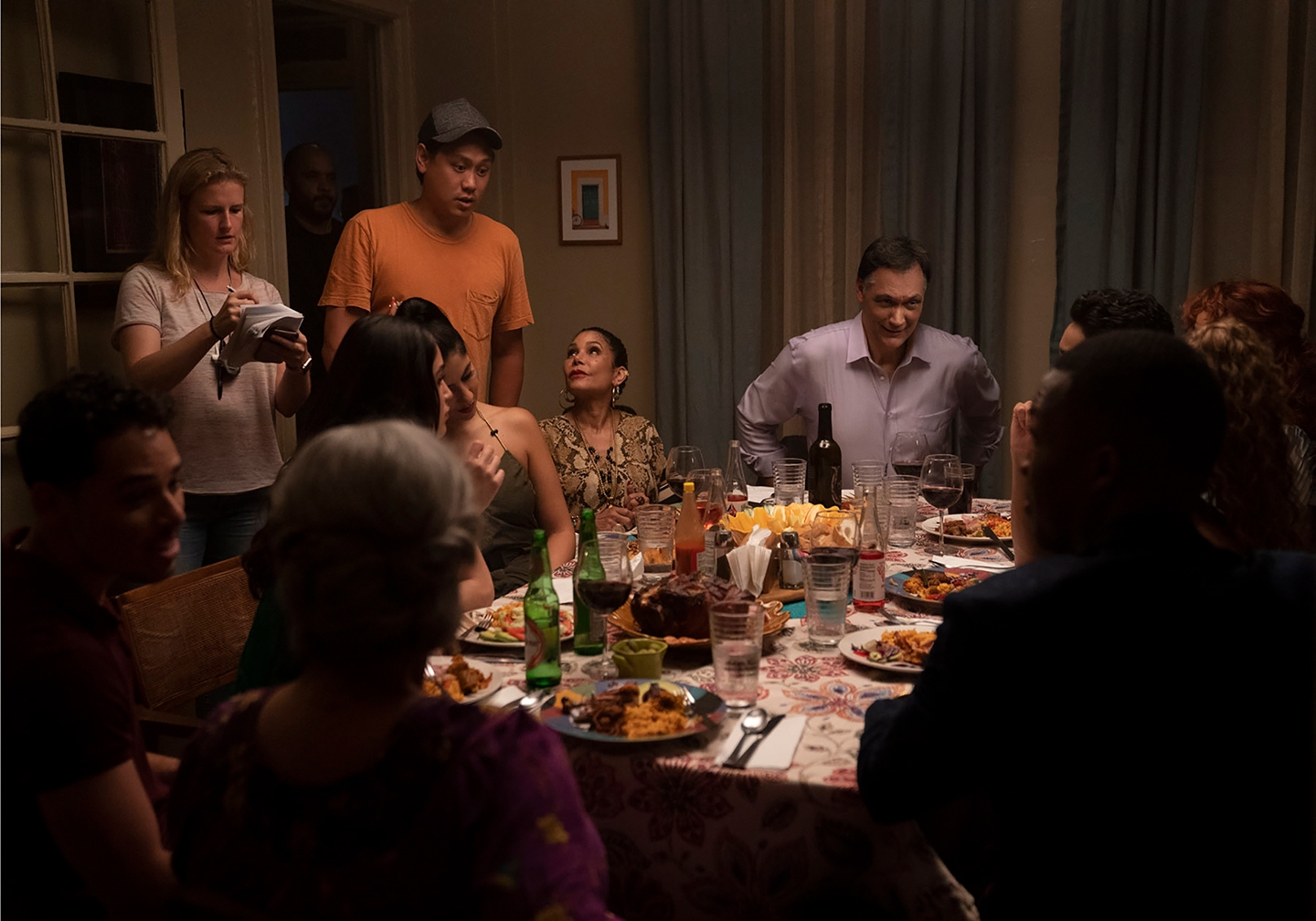
Meanwhile, Miranda’s career was skyrocketing following the Broadway run of In the Heights and the cultural phenomenon Hamilton: An American Musical — which won 11 Tony Awards and now holds the record for the most Tony nominations, with 16. Miranda has also earned more than a shelf’s worth of individual awards for his work, including a Pulitzer Prize, two Laurence Olivier Awards, three Tonys, three Grammys, an Emmy, a Kennedy Center Honor, a MacArthur Fellowship “Genius Grant,” and an Academy Award nomination for his contributions to the Disney animated musical Moana. “Film was my first love,” he tells AC. “Before I fell in love with theater, I was making movies. I grew up in my grandfather’s video store, Miranda Video, in Vega Alta, Puerto Rico. To be unsupervised in a video store is to be in heaven!”
“We’ve got a lot of images reflecting the juxtaposition of big dreams in small places.”
In the Heights is framed by scenes in which Usnavi tells the story of Washington Heights to a group of children. He encourages them to speak the name of the neighborhood “so it won’t disappear.” To reflect changes to the neighborhood, Miranda has updated the musical throughout its various theater runs, and in the feature adaptation, gentrification looms as an ever-present threat. “You never realize your theme as you’re writing,” Miranda muses. “You’re just so fascinated by what you’re writing, and then the themes start to emerge. But legacy, I think, emerges as powerful in both [In the Heights and Hamilton]. ‘Who tells our story when we’re not here anymore?’ Usnavi speaks to that in the finale of the show, and Hamilton is all about that in 50 different ways.”
The medium of film, he adds, further enhances this theme. “Film is forever. And that’s kind of thrilling, right? I’ve been lucky enough to act for film and act for theater, and when you’re acting for theater, your masterpiece is devoured that night, and you’re going to make it again the next night. But with film, you’re sculpting in marble, and the camera does that. The relationship to the camera is something I’ve thought about so much, particularly in my medium — the medium I’ve spent my life trying to get good at — which is telling stories with music. There’s a higher suspension of disbelief required when you’re in a movie, because the world looks more naturalistic than it does when you’re on the stage.” With a laugh, he adds, “There’s lots of ways to do it right, and there’s lots of ways to do it wrong.”
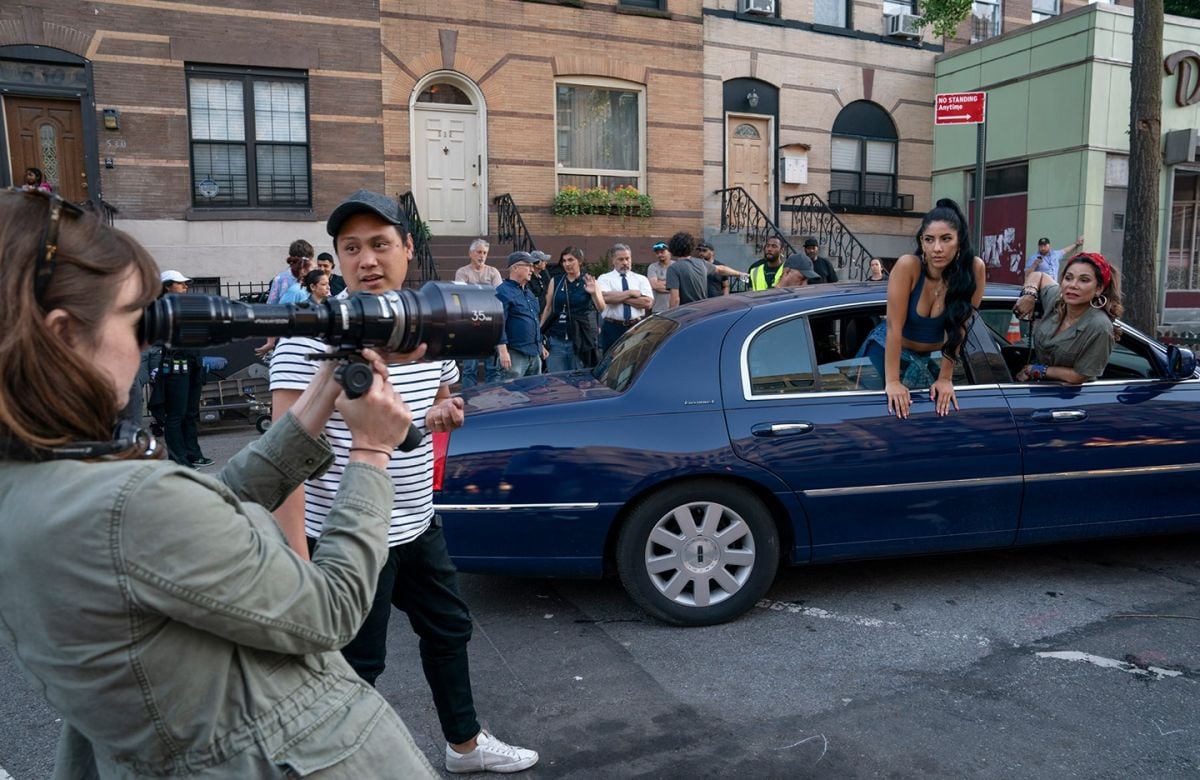
Film also allows for Washington Heights to emerge as a more prominent character in the adaptation, as the movie was shot on location. “What’s wonderful about how Jon and Alice work is that they’re meticulous planners who also allow for the magic to happen,” Miranda says. “And if there’s magic happening on their set, they point their camera in that direction. There are beautiful candid shots of motorcycles going through our frame, and kids opening hydrants on their own, that have nothing to do with our production! [There are even shots of] people hanging out of windows, watching [us make] our movie. And, yeah, we’ve got to go up and get a release from that person, but they’re in our movie now, because they’re part of [the neighborhood] and they’re here. There’s a beautiful shot of Vanessa [played by Melissa Barrera] running down the street, and Jon and Alice’s addition is the fabric that she sees in her mind — these tapestries [start] coming down [from the sky] as she runs. [Their collaboration takes] it to the next level. This could have been like a cheapy indie musical, but at every stage, Jon chooses the most cinematic choice. [He asks], ‘What can’t we do on stage at the [Richard] Rogers [Theater]?’”
The result of that ambition is a visual feast of color and movement featuring Busby Berkeley-style synchronized dance sequences in the Washington Heights Highbridge Pool; stirring, intimate moments with neighborhood residents fantasizing about their “el sueñito” (little dream); and a “Carnaval del Barrio” celebrating the many Latinx cultures within the neighborhood. Chu says he and Brooks used art installations within cities as an inspiration to answer, in visual language, the question of “How do dreams feel?” In conveying the characters’ dreams, he and his collaborators chose to ground the fantasy sequences in their real locations. “We weren’t cutting to a beach or a mansion [in those moments],” he says. “The mansion comes to the streets, so for Vanessa, the drapery comes to the buildings. We’ve got a lot of images reflecting the juxtaposition of big dreams in small places; big hearts in small places; grand feelings in intimate proximity. This is how we tried to build the dynamics of our space for the movie: where the audience was going to sit with us, and how close and how far [from the onscreen action] we could be.”

Three striking musical sequences occur around a power blackout in the middle of a heatwave, when the characters are literally and emotionally “powerless.” The first two of these, aptly dubbed “The Club” and “Blackout,” are preceded by a tense community/family dinner in an apartment as Usnavi and Vanessa prepare to go on their first date. The nighttime sequence was shot over two days in very tight quarters — a 900-square-foot apartment in Harlem. Brooks notes, “The intention of the scene is this promise of a really exciting, really great night. It turns [tragic], but that was the initial promise. The intention of the camera is for the audience to feel like they’re at the dinner table with everyone — that they’re not observing, but actually participating as one of the community members seated at the table with everyone else. We wanted [the tone of the scene] to feel very warm. Jon grew up around food, so [for him], food is nourishment and showing your love and respect for other people. At the beginning of the scene, we wanted to invite all of those sensory experiences of food, so we did all these detail shots of food, mostly lit with practicals. We did a lot of long-lens shots — over people’s shoulders or in between people — with 10 people at a dinner table for a scene that plays for nine minutes of screen time. It was hot, and it was intense.”
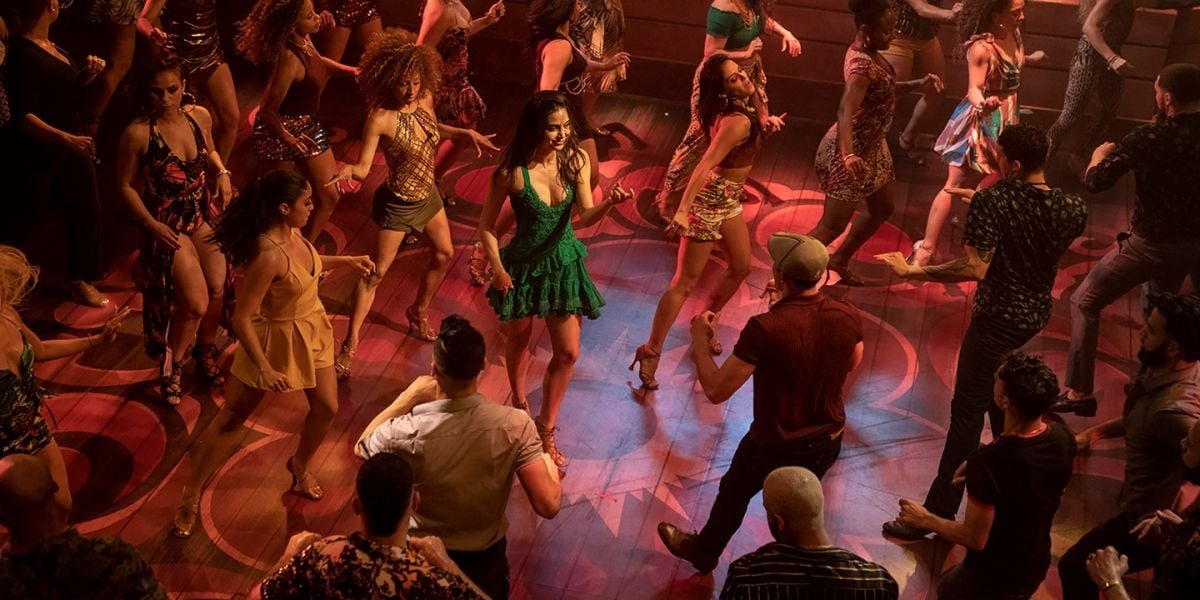
The apartment shots are juxtaposed with a crane shot that pulls back to reveal a vibrant, fast-paced night of clubbing, with dancing and drinks, after Usnavi and Vanessa embark on their date. The nightlife sequence was shot at a club in Manhattan’s Chelsea neighborhood; in an effort to be economical and expedient, the team used many of the venue’s existing lighting units, which were already programmed into a dimmer board. Brooks met with theatrical lighting designer Christina See to pick the setting’s predominant colors: rust, amber and an occasional cyan light that panned through the club. “We wanted to make sure there was a cool color somewhere so that you always feel the warmth, instead of just getting used to it,” she says. “We programmed all the light cues to be locked into the timecode of the music track.
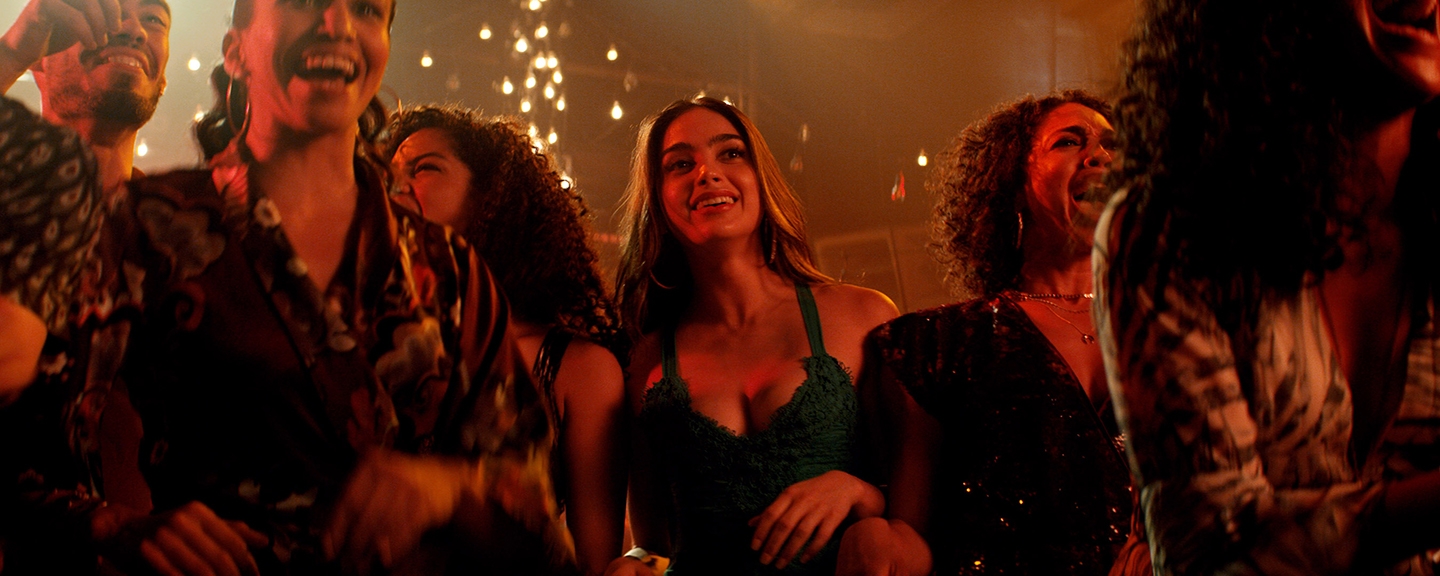
“At the club, our characters are experiencing all of this internal turmoil, and their confusion and frustration play out in the music and the dance,” Brooks continues. “The moving lights [of the club] bounce off reflective surfaces, creating this chaos. We use a lot of crane shots and Steadicam as we flow through the space, but it’s really about these two people who just can’t quite get together. Then, as the lights go out, we cut to an exterior helicopter shot [from a perspective] north of the George Washington Bridge, facing south, and you see all of the lights in Washington Heights and northern Manhattan shut off, with the rest of the city’s still on.”
The scene cuts back to the club, where the patrons have turned on their cellphone flashlights to illuminate the space. This part of the sequence was lit solely with practical cellphones, Brooks says, and the camera strategy switched to handheld coverage to convey the panic of the blackout. “The choreographers would stand next to the camera with flashlights, and two [members of the] choreography team would pan different lights [in sync] with the cellphones in the exact right count,” she says.
“The theme of ‘Blackout’ is being powerless and not being able to control your future and the world around you. And that’s when relationships become really important — when we are powerless. I think this past year has really shown that we all now understand what being powerless means, to an extreme degree. And these lyrics were written in 1999, because certain communities do feel powerless. This movie was supposed to come out last summer, and I think it means so much more now than it would have then.”
The action then takes a slight respite as community members return to the apartment of Abuela Claudia (Olga Merediz) — where they interact amid a warm palette created with candles and colored glass atop cellphone flashlights, complemented by LiteGear LiteMats — while people on the street below are bathed in the glow of fireworks illuminating the neighborhood. “175th Street is right outside Abuela’s window, and you can see Audubon Avenue,” Brooks notes. “We put two or three SkyPanel 360s on each rooftop at that intersection and all the way down the block to the next street, in both directions. Some SkyPanels created our night ambience that was set to 4,700 Kelvin, and the others provided our fireworks effect.”
Brooks and her family took a trip to Disney World prior to starting work on In the Heights, and despite being on vacation, she saw an opportunity to study the light patterns of the nightly fireworks at the parks, though she didn’t actually watch the displays. Instead, “I watched my daughter watching the fireworks. And I realized that the white pop was really what sold it because, as we did in the club with the occasional panning of cyan light, the white pop makes your eye not get used to the constant color.”
In the stage production, “Blackout” leads to a crescendo as it closes Act One before the intermission, but due to the differing structure of film, “the music becomes the soundtrack of the night as people adapt and adjust to the darkness that the blackout brings,” Miranda says. “I’ve been rewriting ‘Blackout’ for half my life, because every time I made a change in the story, I’ve had to rewrite ‘Blackout’ since the development of the original musical. It’s a moment where everyone is careening in different directions as a result of this neighborhood moment, and the movie was no exception. I basically said to Jon, ‘Let me be included in this because I’ve rewritten this a lot of times, so let’s find the best build of the song that leads to the moment you want it to lead to.’ And we knew it was going to culminate in Abuela’s death.”
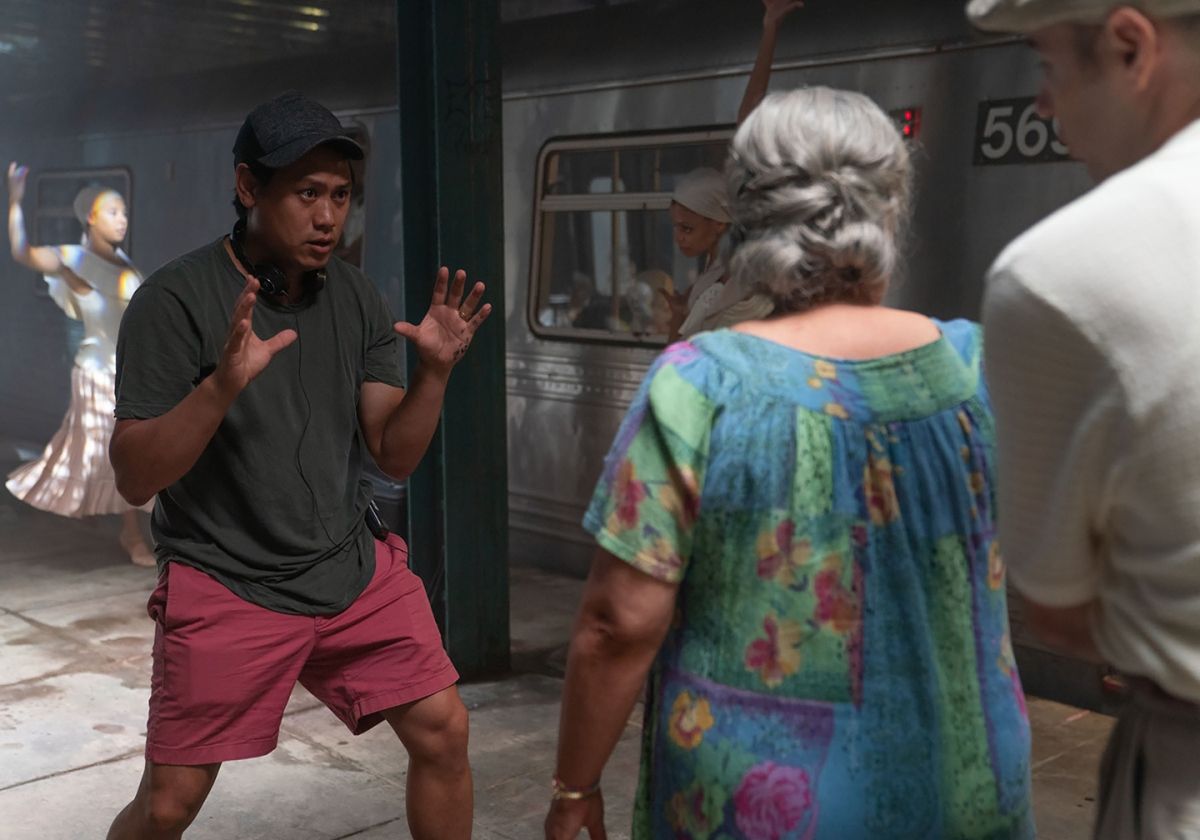
The musical sequence that follows “Blackout” presents Abuela Claudia’s deathbed song, “Paciencia y Fe.” But, Miranda notes, this arrangement was a direct result of his collaboration with the filmmakers, “because we didn’t find ‘Paciencia y Fe’ to go after ‘Blackout’ until the edit. That was a thing [editor] Myron Kerstein tried out, and it worked beautifully,” he reveals. The song conveys Abuela Claudia’s reflection on her life as an immigrant from Cuba as she moves between subway trains from different eras with passengers representing her life in Cuba and New York. “We wanted to bring her out of the subway and slowly tell her story as almost the shadows of her memory, but [in a way that would be] as elegant and beautiful as the stories we tell by a campfire,” Chu says. “We wanted to show how we romanticize [our own stories in] our heads — because sometimes we have to tell our stories in romantic ways to survive. We wanted to reflect that this is her story. It’s not a sad story, it’s a hard story — it’s a struggle story. But her spirit rose above all of that and made it a beautiful one.”
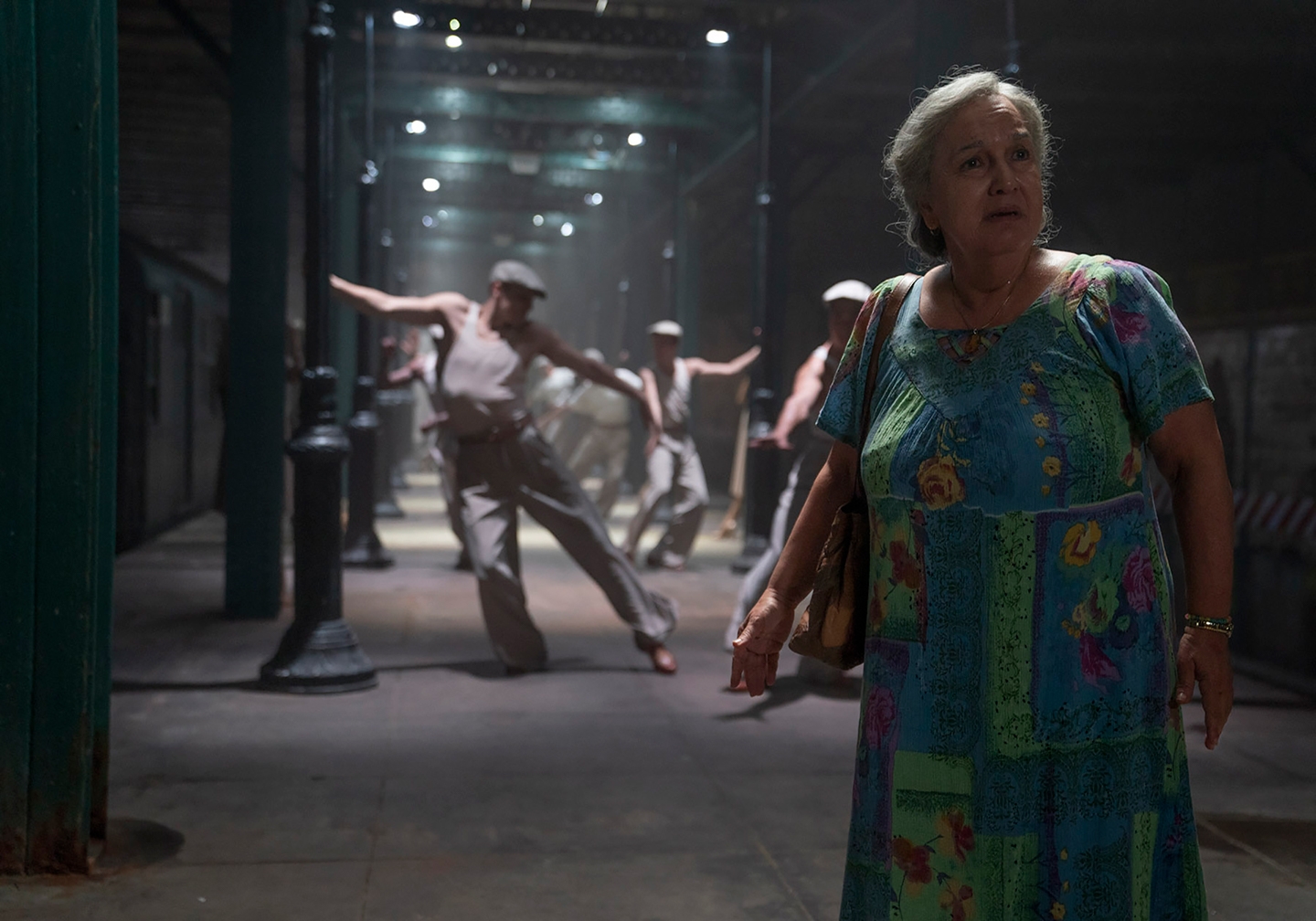
“Sometimes we have to tell our stories in romantic ways to survive.”
The filmmakers shot the sequence at a large, two-platform abandoned station in Brooklyn with actual vintage subway trains. “Shooting in the subway was a major challenge because we were three stories underground, there were no elevators, and we had enough lights and cable for a whole theater,” Brooks explains. “It was so hot down there; the air was so thick and we needed to bring atmosphere down there, too. The sequence involved a massive number of lighting cues, and we didn’t have a pre-light day. We just had a test on a stage.” The color palette represented Abuela Claudia’s two residences — Cuba was warm, and New York was cool.
When the team found an appropriate tunnel lined with vibrant graffiti at the 191st Street subway station, they knew it was the right place to end Abuela Claudia’s song. “It took a while to figure out how we were going to transition [from the fantasy sequence] back into the subway car [in reality],” Chu says. “And it was Alice and gaffer Charlie Grubbs who suggested, ‘What if we just put up a light on the subway set that looks like a subway pole, and when she touches it, we’re back?’ And it was just so beautiful, so elegant, the way that pops back [into an actual subway pole] and moves into the 191st Street tunnel.” The tunnel was 900' long and “we had Chroma-Q Studio Force IIs every 5 feet apart, all the way down the tunnel, set up on either side,” says Brooks. “But the most magical thing was that it was over 100 degrees that day and very humid, and the tunnel was literally sweating. The whole tunnel was wet down by Mother Nature, and it glistens with the light because it’s just sopping wet.”
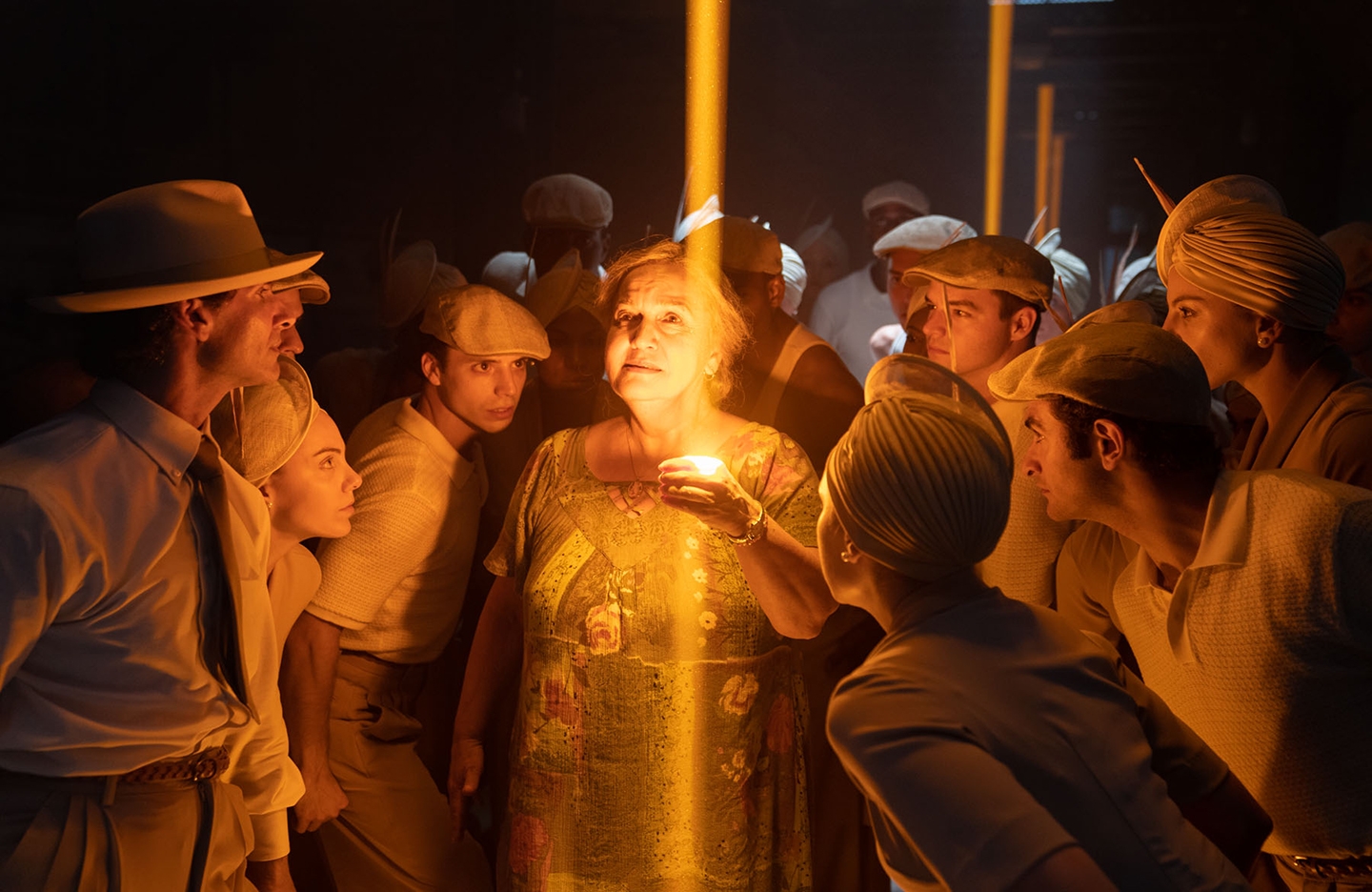
In the edit, when the filmmakers considered moving this sequence to mark Abuela Claudia’s death, Miranda saw how it could work. “There’s one additional piece of music inside the original song, and I said, ‘If you cut this, it works perfectly,’” he says. “She sings, ‘I made it through, I survived, I did it. Now do I leave or stay?’ And in the original song, she would [continue], ‘I buy my loaf of bread, continue with my day.’ And if you just cut that part out and leave her with that question as the last thing she’s wrestling with, then we understand everything. We actually understand that it’s a bigger question. ‘Leave or stay’ is not DR or New York; ‘leave or stay’ is earth or the next place. So literally through that edit, just cutting the next section of music makes the question much more profound.”
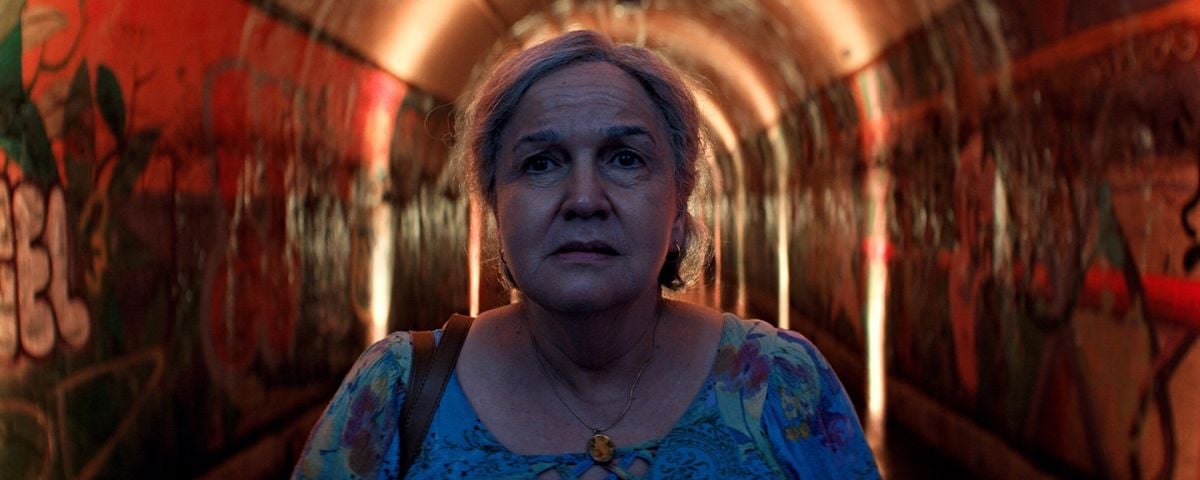
The film’s end-credit sequence shows a number of pictures of Washington Heights taken by local photographers. “We wanted to give a forum for the local people to show how they saw their neighborhood,” Chu says. “All of those pictures were taken by local photographers and inspired us while making the movie; we would talk to them about the images, where they got them, and how they see them. Using their images in the end credits is beautiful. It’s one of my favorite parts of our movie. After watching our interpretation of this fantasy world that Lin wrote his musical about, getting to see the neighborhood through their lens was pretty special to me.”
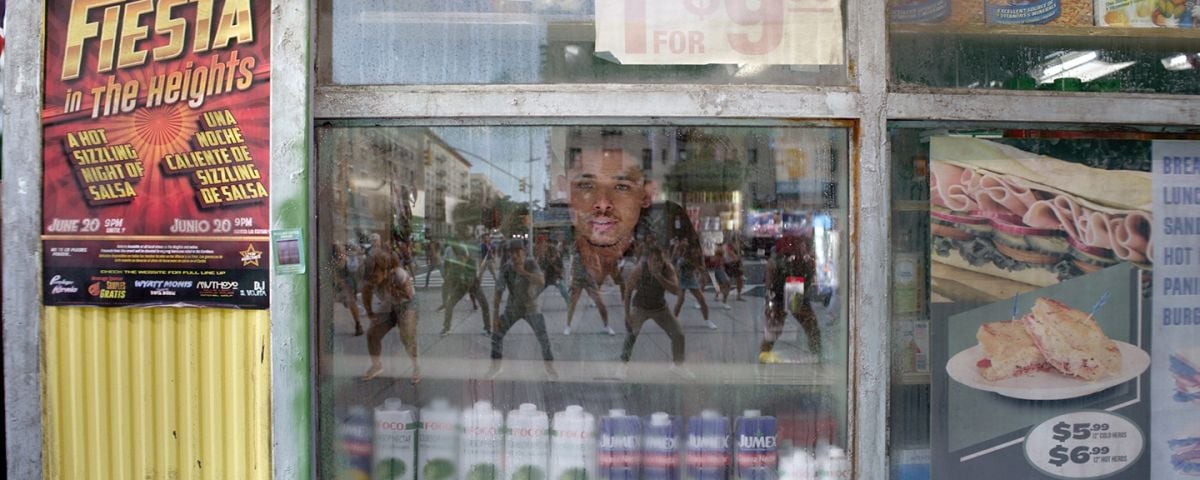
Following the production of In the Heights, Miranda and Brooks teamed up again, on Jonathan Larson’s musical Tick, Tick… Boom!, Miranda’s feature-length directorial debut. “I saw how well Alice and Jon worked together,” Miranda says. “I could see that it was a true partnership, and that was exciting to me. I also saw the magic she was creating with Jon. In the Heights and Tick, Tick… Boom! could not be more different musicals — in tone, in the stories they’re trying to tell, full stop. When I got to sit down with Alice to talk about Tick, Tick, she said, ‘My father was a playwright. We lived in New York and moved in 1990.’ And I was like, ‘I really don’t know how else you could be more qualified.’ She has a lived experience of the Village [during that] time and from the same angle that I did, which was as a child. We were both 10 years old in that era. I knew she would make it look like I wanted it to look. And we just had an amazing time making the film together. We would shake our heads while we were shooting these musical sequences and go, ‘Why do people want to make anything but musicals? They’re so much f---ing fun!’ I’m so happy she’s been able to do this double whammy, going from Heights straight to Tick, Tick with me.”
Tick, Tick… Boom! is scheduled for release on Netflix later this year.
Technical Specs
2.39:1
Camera: Panavision Millennium DXL2
Lenses: Panavision G Series Anamorphic Prime




